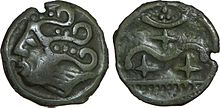
The Durocasses were a Gallic tribe dwelling around present-day Dreux during the Roman period.

The Durocasses were a Gallic tribe dwelling around present-day Dreux during the Roman period.
They are mentioned Durocasis (var.durocacasis) on the Itinerarium Antonini (early 3rd c. AD), [1] as Durocassio on the Tabula Peutingeriana (4–5th c. AD), and as Dorocas on Merovingian coins. [2] [3]
The etymology of the ethnonym Durocasses remains unclear. The meaning of the second element -casses, attested in other Gaulish ethnonyms such as Bodiocasses , Sucasses , Tricasses , Veliocasses , or Viducasses , has been debated, but it probably signifies '(curly) hair, hairstyle' (cf. Old Irish chass 'curl'), perhaps referring to a particular warrior coiffure. [4]
The city of Dreux, attested ca. 930 AD as Drocas (Drewes in the 12th c.), is named after the Gallic tribe. [5]
The production of coins by the Durocasses suggests that they benefited from some economic autonomy. Their wealth probably came from tolls collected on the inland water shipping on the Eure river. [6]

The Bituriges Cubi were a Gallic tribe dwelling in a territory corresponding to the later province of Berry, which is named after them, during the Iron Age and the Roman period. They had a homonym tribe, the Bituriges Vivisci, in the Bordelais region, which could indicate a common origin, although there is no direct evidence of this.
The Viducassēs were a Gallic tribe dwelling in the modern Calvados department during the Iron Age and the Roman period.

The Aulerci Cenomani were a Gallic tribe dwelling in the modern Sarthe department during the Iron Age and the Roman period. The Cenomani were the most powerful of the Aulerci tribes.

The Petrocorii were a Gallic tribe dwelling in the present-day Périgord region, between the Dordogne and Vézère rivers, during the Iron Age and the Roman period.

The Bodiocasses or Baiocasses were an ancient Gallic tribe of the Roman period. They were a tribal division of the civitas of the Lexovii, in the Roman province of Gallia Lugdunensis.
The Caletes or Caleti were a Belgic or Gallic tribe dwelling in Pays de Caux, in present-day Normandy, during the Iron Age and the Roman period.

The Lemovīcēs were a Gallic tribe dwelling in the modern Limousin region during the Iron Age and the Roman period.

The Eburovīcēs or Aulercī Eburovīcēs were a Gallic tribe dwelling in the modern Eure department during the Iron Age and the Roman period. They were part of the Aulerci.

The Ambiani were a Belgic coastal tribe dwelling in the modern Picardy region during the Iron Age and Roman periods.
The Nantuates or Nantuatae were a Gallic tribe dwelling around present-day Massongex, in the modern Canton of Valais (Switzerland) and adjacent areas of France, during the Iron Age and the Roman period.

The Coriosolites or Curiosolitae were a Gallic people dwelling on the northern coast of present-day Brittany during the Iron Age and the Roman period.

The Redones or Riedones were a Gallic tribe dwelling in the eastern part of the Brittany peninsula during the Iron age and subsequent Roman conquest of Gaul. Their capital was at Condate, the site of modern day Rennes.
The Tricasses were a Gallic tribe dwelling on the upper Seine and the Aube rivers during the Roman period. Until the first century AD, they were probably reckoned among the Senones.

The Bituriges Vivisci were a Gallic tribe dwelling near modern-day Bordeaux during the Roman period. They had a homonym tribe, the Bituriges Cubi in the Berry region, which could indicate a common origin, although there is no direct of evidence of this.

The Andecavi were a Gallic tribe dwelling in Aremorica during the Roman period.

The Gabali were a Gallic tribe dwelling in the later Gévaudan region during the Iron Age and the Roman period.
The Veliocasses or Velocasses were a Belgic or Gallic tribe of the La Tène and Roman periods, dwelling in the south of modern Seine-Maritime and in the north of Eure.

The Cadurci were a Gallic tribe dwelling in the later region of Quercy during the Iron Age and the Roman period.
The Silvanectes were a small Belgic tribe dwelling around present-day Senlis (Oise) during the Roman period.
The Quariates or Quadiates were a Gallic tribe dwelling in the valley of Queyras, in the Alps, during the Iron Age.